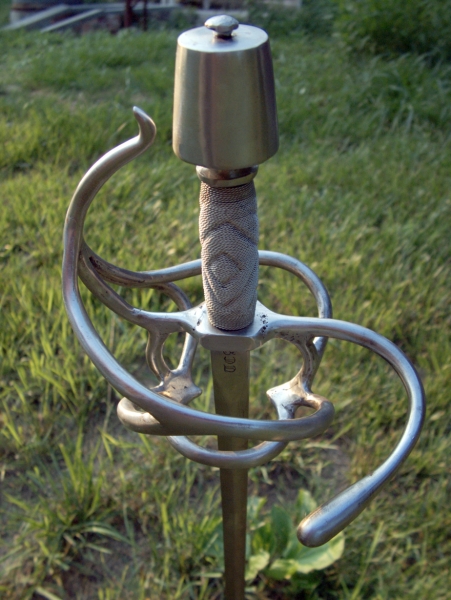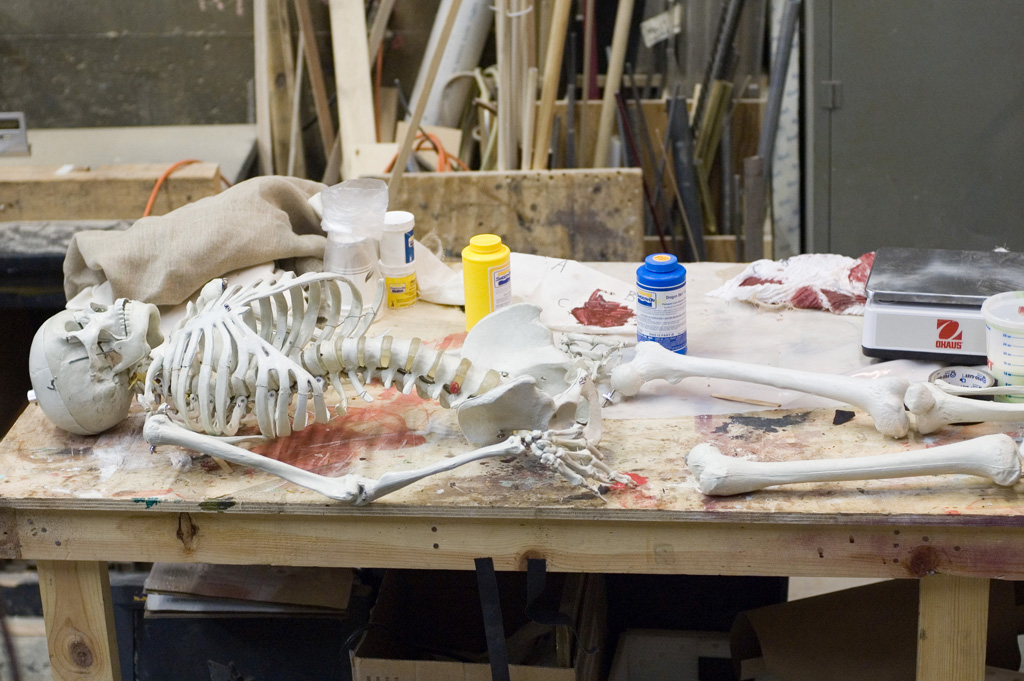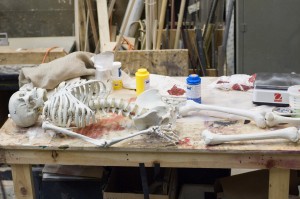From Costumes and Scenery for Amateurs, by Constance D’Arcy Mackay, 1915 (pp 93-95)
Properties and How to Make Them
Use care in the selection of your properties. Study your text. Avoid anachronisms. Do not use muskets and pipes in a scene that is laid before muskets were invented and tobacco discovered. Do not use modern lamps to light a mediaeval scene. Do not use modern musical instruments in a scene that is laid in Grecian or mediaeval times. These are some of the average mistakes. Remember that penholders and pens are a modern invention. Use quill pens and sand for plays whose scenes are laid before the early nineteenth century. Do not use clocks in Greek or early Saxon scenes. If your characters are writing or sending letters in the time when parchment was used, have the paper yellowed to look like parchment. Do not have a modem fireplace in a peasant’s home where the hearth would naturally be built of stone. Do not use modern dishes in mediaeval scenes. Buy paper plates and cover them with colored tissue paper, or paint them till they resemble the kind of platters you need. Brown will represent earthenware. Gold and silver for fairy palaces can be made by gilding them over or covering them with gold paper. Remember that forks and spoons were not in popular use in the days of Robin Hood. Fingers and knives did the required work. The hearth was used for cooking. Beware of modern cooking utensils in fairy, Puritan or Colonial scenes. “Gad- zooks” and modern coffee pots do not go together. Beware of modern frying pans for hearthstone scenes. Use iron skillets instead. A kettle for these scenes is always permissible, but if it is a peasant scene, see that it is not the too shining brass of the tea kettle of the afternoon tea table. Remember that coal fires are modern. If you are having a fairy peasant scene use wood instead. Use braziers where the scenes require it. They are always effective; and can be made by blacking a tripod washbowl, and lighting a little red fire powder in it, or some joss sticks which will give a thin blue smoke. Or a red electric bulb can be used in it if there is no spot light.
Be careful of your lighting. The Greeks had torches when they wanted a bright light, and small, bowl-shaped lamps with a wick and oil for smaller illuminations. Gold cardboard torches from which stream slashed strips of flame-colored tissue paper are safe substitutes. The Saxons and early English had rushlights and bowl lamps. A bowl that looks like earthenware, with the stub of a candle in it, will do. In mediaeval times swinging lamps and candles were for the rich; while the humble were content with tallow dips only.
Don’t use the spinning wheel before the spinning wheel was invented, just because it is decorative. Don’t use a modern glass “tumbler” for your doublet and hose hero to drink from. A cheap glass goblet covered with gold paper will look like a gold goblet.
If possible have your youthful players make their own properties. Take, for instance, a fallen tree trunk, or a log for a forest scene. It can be made by fastening together two small vinegar barrels, and covering them with green and brown burlap to represent bark and moss. Or it can be covered with brown burlap and gray lichen—real lichen fastened to it with strong glue. Such a stage property as this can be used again and again. And the boy who went to the outlying fields or suburbs to get the moss—may he not know something of nature’s secrets that he had not known before? And may not the eager quest bring him hours of entire happiness? A seventeenth-century broom can be made by tying an armful of hazel or willow switches to an old broom handle. The browner and sturdier these twigs are the better. This broom material can be gathered at the same time as the moss.
From Costumes and Scenery for Amateurs, by Constance D’Arcy Mackay, 1915 (pp 93-95)






